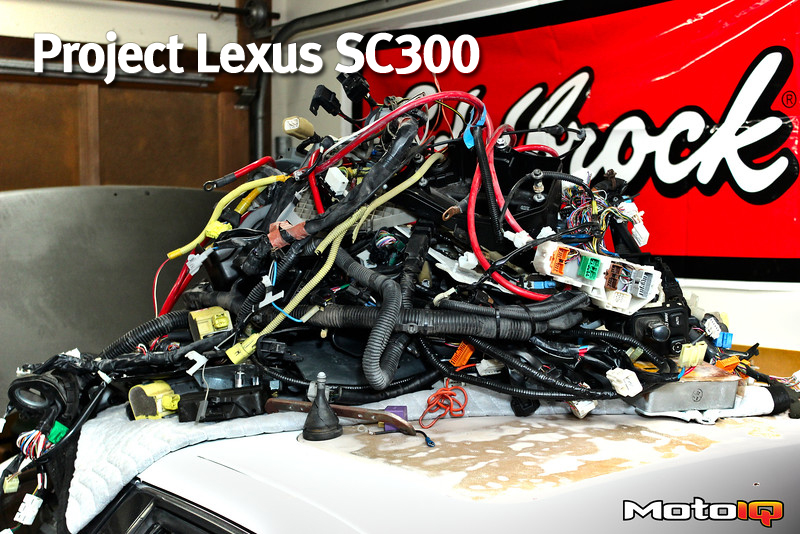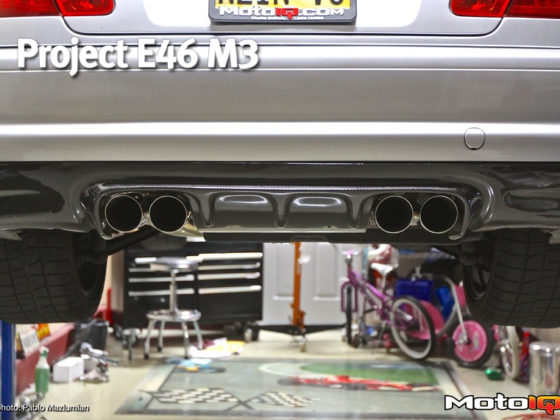
Project Lexus SC300 Road Racer: Part 4 – Beginning the Epic Rewire
Mr. Cooper was the teacher for my 8th grade math class, and he always used to say “there’s the right way, the wrong way, and the Army way.” When it comes to wiring, there are even fewer choices: right, and wrong. While drag racers have the luxury, if you will, of not having to run in foul conditions, road racers get no such reprieve from most weather. Rainy and humid conditions are no excuse to get off the track, and the electronics in the car need to be able to stand up to the abuse.
Further, while even a mile- or two-mile-long drag race lasts mere seconds, road races involve twenty or more minutes of action (hours in the case of an endurance event) complete with curb (and other cars, sometimes) bouncing, an extremely wide range of vibrations, and more.
This isn’t to say that drag racing electronics are inferior. In fact, as many MotoIQ articles have shown, some of the technology stuffed into drag cars today is extremely powerful. In some cases they are even more well-equipped than road racing cars in that regard. That being said, where many typical race cars fall short is in the wiring department.
There is not a lot of documentation and there are not a lot of books out there when it comes to “race car wiring”. There are only a few quality resources, but there are an awful lot of forum posts and “hand-me-down” knowledge. Myth masquerades as truth.
 What does it all do?
What does it all do?Think about it this way: You’ve spent many tens of thousands of dollars in mods and labor on your track day car. You’ve bought great safety gear. You’ve spent hundreds of dollars on your track day weekends, hundreds of dollars on hotels, hundreds of dollars in fuel to tow out to the track. You start the car for your first session, pull out of the pits and go through the first couple of turns. You roll into the throttle and…. that’s all she wrote. Nothing. She’s dead, Jim. If you’re lucky, you just wasted a thousand dollars on a throw-away track weekend where your car isn’t running, all because of a 50-cent splice that’s garbage. If you’re unlucky, your car burns down, or some sensor that Johnny tuner wired up for you is reading wrong and you drive two laps with no oil pressure and lose an engine.
If you’ve been around racing long enough, you’ve seen all of these terrible wiring jobs sideline people at some point or another. Many “tuner” cars involve a hack job of piggyback controllers, terrible splices, and just all-around bad practices when it comes to wiring. While the last few years have seen movement towards complete plug-and-play replacement systems, in many cases making upgrades easier (look no further than replacement units from companies like AEM and others), factory wiring was never designed with the race track in mind. I’ve even seen people spend countless hours chasing gremlins in stock-ish cars with factory wiring harnesses, especially on older vehicles.
 If you remember the history on Project Lexus SC300, you’ll recall that through a round-about situation I purchased this car for nostalgic reasons.
If you remember the history on Project Lexus SC300, you’ll recall that through a round-about situation I purchased this car for nostalgic reasons.It belonged to my friend and former race team owner, Sae Kang, who passed away. No disrespect to the deceased, but the car had been a long-term project that did not receive the highest quality wiring modifications, and had many of the classical bad practices were employed. To make things worse, since I was not the original builder, and the car came with no documentation, everything was a black box.
As one interesting example, while the car had an aftermarket ECU with its own harness, much of the factory wiring system was still in place, including the factory ECU. I accidentally found out one day that even the factory Lexus alarm was still present and functional! The car had strange behaviors. You couldn’t remove the ABS fuse and keep the car running, but the factory wiring diagram indicates no connection between these systems. When it came time to put in the fuel cell, which would require some minimal wiring, I decided that I was going all-in. The car would be completely gutted of all its factory wiring. All doohickeys, doodads, whatchamacallits, whosamadingers, and whatsits would be removed. The only things that would go back in would be things I knew about and planned for. The only wiring that would be kept was the Haltech Platinum Sport 2000 plug-and-play harness for the 2JZ engine.
In the lessons learned department, when you get a new project car that used to be someone else’s project car, you’ve already made a mistake. More seriously though, if the car isn’t extremely well documented, take it completely apart and start over.
Really.
It’s worth the investment in time, as it will save you a lot of time and money in the long run. I tried, in vain, a few times to pick up where things had left off. This time, I would not make that mistake. Unfortunately, I had to deal with my prior mistakes.
 Since the cage had been put in while much of the factory wiring was still in place, it meant that the heater core and HVAC systems were still behind the dash.
Since the cage had been put in while much of the factory wiring was still in place, it meant that the heater core and HVAC systems were still behind the dash.And behind the dashboard support.
Which was now welded into the cage.
Some creative work with a sawzall got the blower assembly out. Here, my buddy John who used to live down the street is helping me pull out stuff. He owns some very nice Celica-Supras, if you’re wondering.



